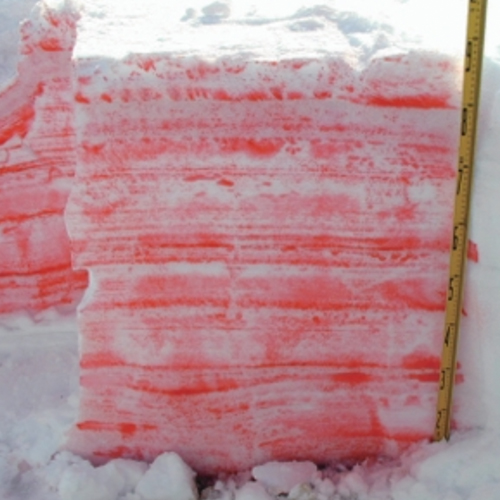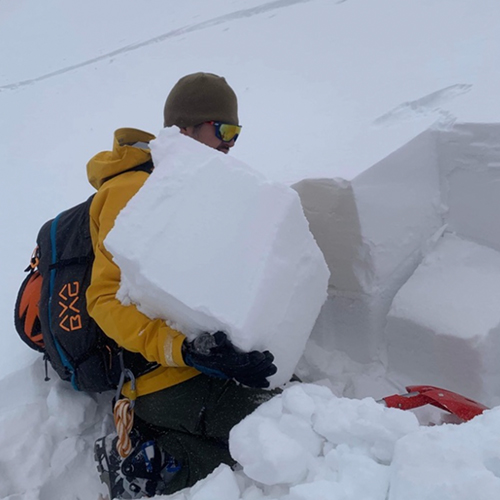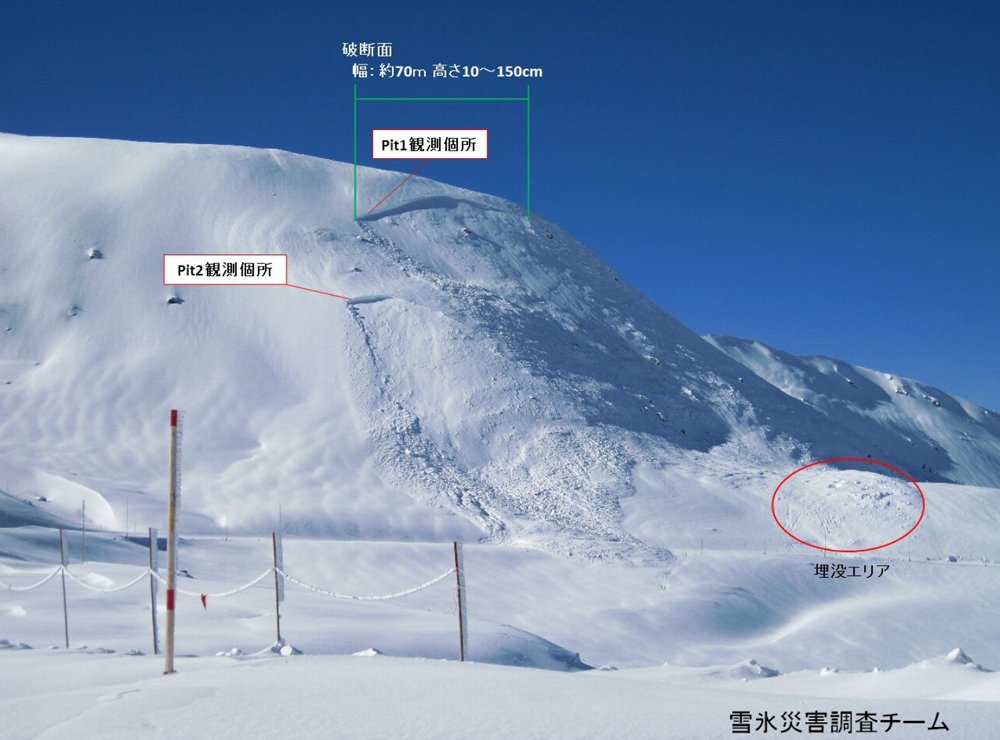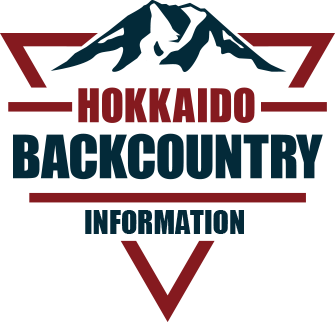Keeping safe in the Hokkaido backcountry
Know the risks
Navigation
There are almost no markers on backcountry routes in Hokkaido. In heavy snow or strong winds, it is not uncommon for skin tracks or footprints to disappear within a few minutes. Therefore, you need the skills to navigate on your own. In case your smartphone is lost or damaged, we recommend that at least two people in your party have the map and route pre-installed on their smartphone, available for use offline. Carrying a paper map and an analog compass is also effective.
Daylight hours
Sunrise on Christmas in Hokkaido is around 7am, sunset is around 4pm,allowing for only nine hours of daylight. In the middle of winter, heavy snow shortens the useful daylight hours even more, limiting hours available for backcountry tours. In late March, sunrise is at 5:30 am and sunset is around 6 pm, meaning there are three more hours of daylight. Be sure to bring a headlamp and be prepared for any unforeseen circumstances.
Popular Routes
On the popular backcountry routes around Niseko, Daisetsuzan, and Furano, skiers often share the route with other parties. It is important to be aware of the positional relationship with other parties and take care not to put each other in danger.
Terrain Traps
Gullies are a common feature in Hokkaido, and can provide some good skiing.Unmarked waterfalls are common, however. So be especially careful on slopes where you cannot see very far ahead. Of course, when an avalanche occurs in a gully, you may be buried very deep. For example, on the popular Mt. Yotei, there have been many fatal avalanches where people were buried three to five meters deep. Be sure to carefully observe and assess the terrain ahead of you when descending.
Visibility and Storms
It snows a lot in Hokkaido. It’s not uncommon for there to be only one sunny day in a week. Therefore, when visibility is poor or the wind is too strong, you need to plan your backcountry tour flexibly according to the weather, such as enjoying skiing in the forests at lower altitudes.
Deep Snow
Deep snow is great for skiing, but once you fall, it’s hard to get up and it takes a lot of energy. If you are unable to get up in deep snow, you may suffocate and die. It is important to learn how to get up in deep snow and keep a close eye on your teammates as they ski.
Lack of physical strength
Physical strength is a very important factor. Hokkaido gets a lot of snow, which means breaking trail through the deep Hokkaido powder can be very physically draining. Since you will be spending more time than usual breaking trail, it is important to plan your backcountry trip accordingly. Fatigue reduces not only your physical abilities but also your judgment. Lack of physical endurance can result in longer than anticipated time in the backcountry, or even the possibility of party members not able to exit the backcountry under their own strength. Make sure to plan your backcountry tour with all party members’ current physical conditioning in mind.
Lack of skiing ability
Technique is very important in backcountry skiing. In the backcountry, you may encounter much steeper slopes than on groomed resort slopes. Difficult snow surface conditions, such as ice and crust, are also common. Hone your skills with a day on the groomers before heading out into the backcountry.
Getting lost
In Hokkaido, the main cause of winter search and rescue callouts is due to skiers getting lost in the backcountry. Improve your map reading skills and use your cell phone’s GPS, topographical maps, and compass appropriately. The risk of getting lost increases especially in whiteouts, when visibility is poor and everything is completely white above the tree line.
Avalanche
Avalanches usually cause a complete loss of control for the skier or snowboarder. They are powerful, and often drag victims through trees and rocks, causing serious injuries. If you’re buried in an avalanche, it is usually impossible to extract yourself on your own. You will suffocate to death if you remain under the snow. We will go into more detail about avalanches in the following section, “Understanding Snow and Avalanches.“
Falling into streams and tree wells
Compared to the large topography of Europe and the United States, Hokkaido’sterrain has many small topographical features, such as streams, gullies, and ridges. Instreams, rivers flow under the snow and can be like pitfalls, and accidents of fallinginto waterfalls and other places are common. This danger is particularly common
at the beginning of the season and in spring when snow cover is thin. In addition, tree wells are formed around the bases of large trees where the snow melts due to the heat of the tree trunks. Combined with the light and deep snow in Hokkaido, if you fall
head first into a tree well, you will have a hard time getting out, and in the worstcase scenario, you may suffocate to death.
Falling into glide cracks
Under all the perfect Hokkaido powder snow often lies sasa bamboo grass. This slippery vegetation can act as a weak layer in the snowpack. It’s common in Hokkaido for the entire snowpack, often several meters thick, to slide on this bamboo grass. This causes deep glide cracks to open up in the middle of slopes. A fall into these cracks not only leads to injury, but it can be difficult to get out of them on one’s own. Always scout the slope when ascending, and be careful on slopes where you cannot see the entirety of the slope when descending.
Tree bombs (snow falling from trees)
Perhaps due to global warming in recent years, we are seeing more and larger snow clumps developing in trees. When the larger ones drop, usually without warning, they can seriously injure anyone who happens to be under them. Please take care when passing under such “Tree Bombs”, and when taking a break. Tree Bombs that have dropped naturally are also a hazard. These huge, hard chunks of snow can cause falls or injuries, so be sure to check the snow surface carefully as you ski down.
Cold
Hokkaido is one of the coldest regions in Japan. In inland areas such as the Daisetsu Mountains, temperatures often drop below minus 20 degrees, and when accompanied by strong winds, it can feel as low as minus 30 degrees. The cold can sap your strength and can lead to hypothermia. Also, if you do not wear gloves properly, your fingertips may get frostbite. Also be prepared for longer-than-expected stops during a backcountry tour. Take enough insulating layers to keep warm if, in the worst case, you need to bivouac overnight.
Slips
Contrary to many skiers’ expectations, steep slopes and ridges can become very icy in Hokkaido. If you fall, you may hit a rock or tree and suffer serious injuries, so try to avoid areas where there is a risk of falling. By using ski crampons, ice axes, or crampons properly, you may be able to pass through such areas safely.
Falls and Collisions
Falls and collisions while skiing pose a risk of leading to fractures and other injuries. Furthermore, if you fall in deep snow it can be difficult to get up, causing you to waste extra energy and, in the worst case scenario, leading to suffocation. Always ski at a speed that you can confidently control.
Solo backcountry tours
When you enter the backcountry alone, you have to solve all the problems yourself. For example, if you are buried in an avalanche or fall into a stream or tree well, you may be able to be rescued if you have company, but this is not possible if you are alone. It is best to go into the backcountry with others, and if you must go alone, it is important to have a sufficient safety margins and travel conservatively.
Emergencies and Rescue Operations in Hokkaido
Communications
Cell phone signals are often available near the mountain ridges in Hokkaido, but should not be relied upon. It is best to assume that cell phone signals will not reach the trailheads, so it is a good idea to cache and download all maps before leaving town. Two-way radios are useful for backcountry parties, but they must meet Japanese standards. High-power radios must be registered in Japan. Using radios that are not registered in Japan is illegal and the fines are high.
Emergency
In an emergency where cell phone signals are available, call the police on 110. The police will use your location information to carry out search and rescue. If you are unable to receive a mobile phone signal, your only hope is to wait for a pre-designated caller (such as your accommodation, partner, or friend) to call the police at a pre-arranged time, or use the SOS button on a satellite communication device (such as Garmin inReach or SPOT). Please note that PLBs, which are commonly used overseas, are illegal in Japan. In Hokkaido, you should also be prepared to wait at least three hours, and usually longer, for a backcountry rescue. Hokkaido has trained police and fire backcountry rescue teams, but only in very limited geographical areas (at the foot of Mt. Yotei and in Sapporo). Coordination and travel time for rescuers to reach the trailhead is also time-consuming, and factors such as heavy snow, poor visibility, and nightfall can also hinder rescue efforts. Backcountry parties should prepare for a night on the mountain, even on relatively easy backcountry ski routes. Pack a basic survival kit, including a fire starter and a warm blanket.
Rescue
Mountain rescues in Hokkaido are generally carried out by police and fire rescue teams. Rescues carried out by public agencies are funded by Japanese taxes. when ski resort patrols or private rescue teams are called in, rescue fees set by each organization are charged. Air rescue is handled by public agencies such as the police and fire departments. Since the flight is from Sapporo, the flight time alone is about 30 minutes in the Niseko area, about 1 hour in the Daisetsu area, and about 2 hours in Rishiri.
Falling Snow
Like anywhere else in the world, in Hokkaido, Snow occurs when small ice particles in clouds crystallize and fall to the ground. The shape of the snow crystals that fall varies depending on conditions such as temperature and humidity. The shape of the crystals greatly affects the quality of the snow once it has accumulated.


Accumulated snow and its transformation
Snow that accumulates on the ground is called accumulated snow, and it forms a layered structure with new snow overlapping the old snow. There are multiple layers in the snow that differ in hardness and density, and this layered structure affects the likelihood of avalanches. For example, parts of the snow that have weak bonding strength are called weak layers, and they can cause avalanches. Accumulated snow increases in strength over time as it is crushed by its own weight and snow sticks together. The properties of snow also change within the snow due to various influences such as temperature.
Wind and snowdrifts
Even snow that has already accumulated can begin to move when a strong wind blows. Snow blown up by strong winds moves from upwind to downwind, forming snowdrifts on convex to concave terrain. Slabs with plate-like properties form in these snowdrifts, and because they are often prone to breaking, the risk of avalanches increases.
Typical snowfall patterns in Japan
Snowfall in Japan is mainly classified into “cyclone type” and “monsoon type”. If monsoon type snowfall occurs immediately after cyclone type snowfall, a snow layer with different properties tends to be created in a short period of time. It is also often accompanied by strong winds, which can often increase considerably the probability of avalanches.
Avalanche
An avalanche is a phenomenon in which snow on a slope flows down due to gravity.There are three types of avalanches that backcountry skiers need to be particularlycareful of: surface avalanches, point avalanches, and full-depth avalanches. Surfaceavalanches are the most important because they extend across a wide area and it is easy to get caught up in them. Avalanche sizes are divided into fivecategories based on the amount of snow that is released and the impact of the collision.Most mountain accidents involve surface avalanches of approximately size 1.5 to 2.The size of these avalanches is approximately slightly smaller than a soccer field.

●Avalanche risk and characteristic instability patterns
According to Canadian data, 70% of avalanche deaths are caused by suffocation, 30% by injuries caused by obstacles such as rocks and trees, Hypothermia is rare. If completely buried, the survival rate is 50%. If breathing is restored to the buried victim within 18 minutes, the survival rate jumps to 90%. It is necessary to understand the three factors that can cause unstable snowpack – strong winds, heavy snowfall, and persistent weak layers – and acquire the ability to avoid avalanches.
Companion Rescue
What skiers can do if they are swept away by an avalanche
If you notice an avalanche occurring beneath your feet while skiing, yell out loud and try to ski at a 45-degree angle to get out of the avalanche’s path. If you fall and get caught up in the avalanche, try to swim through the snow and avoid getting buried deep. If you feel that the avalanche is slowing down and about to stop, grab a shoulder strap of your backpack and use your arm to create an air pocket around your face to allow you to breathe. Also, stick a hand out in the direction you think the snow surface is in order to increase the likelihood of someone finding you.
Rescue your party members
If any of your party members are swept away by an avalanche, don’t panic. First think about ensuring your own safety. Next, rely on the avalanche transceiver signal to approach the buried person. Use a probe to identify the buried person’s location and dig them out with a shovel. Rescue requires quick action, and you need to train repeatedly.
First aid
In the event of an accident in the backcountry, professional medical treatment cannot, of course, be provided immediately. Before the victim can be transported to a medical facility, it’s you and your party who will need to provide first aid, often with limited resources. Attend seminars and practice before heading into the backcountry, so you can provide aid without panicking.
Transporting an injured person
After first aid is completed, you’ll need to think about transporting the victim out of the backcountry. You’ll need to take into account your party size, the terrain and distance to the trailhead, the weather, and how much time you have left in the day. There are several methods for transportation, such as extracting the victim yourself, ground transport by rescue teams, and helicopter transport. Even when rescue teams coordinate extraction, parties involved are asked to help, so make sure you’re versed in transporting an injured person in the backcountry.Depending on the situation, rescue may not be possible on the same day. Parties may even have to wait for several days for rescue. It is important that backcountry parties prepare for the possibility of a bivouac with equipment and practice.


